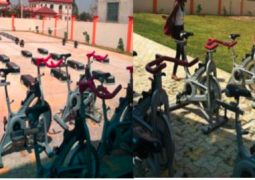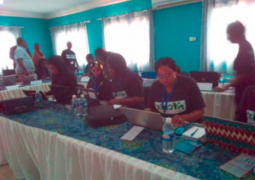Every year, millions of people go missing in highly suspicious circumstances and a huge percentage of them are never found. They are the victims of human trafficking. This is the illegal trade of people for the purposes of commercial exploitation. This industry has been placed second largest, tied with the illegal arms industry, right after the drug-trade.
Human trafficking has been defined as the recruitment, transportation, transfer, harbouring or receipt of persons, by means of the threat or use of force or other forms of coercion, of abduction, of fraud, of deception, of the abuse of power or of a position of vulnerability or of the giving or receiving of payments or benefits to achieve the consent of a person having control over another person, for the purpose of exploitation. Exploitation shall include, at a minimum, the exploitation of the prostitution of others or other forms of sexual exploitation, forced labour or services, slavery or practices similar to slavery, servitude or the removal of organs. The consent of a victim of trafficking in persons to the intended exploitation set forth shall be irrelevant where any of the means set forth have been used. The Council of Europe has said that this industry has reached such high levels it is comparable to an epidemic most of the growth recorded over the past decade alone.
Trafficking is a lucrative industry. It is now the fastest growing criminal industry in the world. Human trafficking usually affects women and children. The total annual revenue for trafficking in persons is estimated to be somewhere between five and ten billion dollars, a massive sum by any means.
The Protocol is the first global legally binding instrument with an agreed definition on trafficking in persons. The intention is to facilitate convergence in national approaches with regard to the establishment of domestic criminal offences that would support efficient international cooperation in investigating and prosecuting of traffickers. An additional objective of the Protocol is to protect and assist the victims of trafficking in persons with full respect for their human rights. The Trafficking Protocol defines human trafficking as:
Human trafficking differs from people smuggling. In the latter, people voluntarily request or hire an individual, known as a smuggler, to covertly transport them from one location to another. This generally involves transportation from one country to another, where legal entry would be denied upon arrival at the international border. There may be no deception involved in the (illegal) agreement. After entry into the country and arrival at their ultimate destination, the smuggled person is usually free to find their own way.
While smuggling requires travel, trafficking does not. Much of the confusion rests with the term itself. The word "trafficking" includes the word "traffic", which is often equated with transportation or travel. However, while the words look and sound alike, they do not hold the same meaning. Human trafficking does not require the physical movement of a person (but must entail the exploitation of the person for labor or commercial sex. Additionally, victims of human trafficking are not permitted to leave upon arrival at their destination. They are held against their will as prisoners, through acts of coercion and forced to work or provide services to the trafficker or others. The work or services may include anything from bonded or forced labor to commercialized sexual exploitation. The arrangement may be structured as a work contract, but with no or low payment or on terms which are highly exploitative. Sometimes the arrangement is structured as debt bondage, with the victim not being permitted or able to pay off the debt.
Bonded labor, or debt bondage, is probably the least known form of labor trafficking today, and yet it is the most widely used method of enslaving people. Victims become bonded laborers when their labor is demanded as a means of repayment for a loan or service in which its terms and conditions have not been defined or in which the value of the victims' services as reasonably assessed is not applied toward the liquidation of the debt. The value of their work is greater than the original sum of money "borrowed".
Forced labor is a situation in which victims are forced to work against their own will, under the threat of violence or some other form of punishment, their freedom is restricted and a degree of ownership is exerted. Men are at risk of being trafficked for unskilled work. Forced Labor can include domestic servitude; agricultural labor; sweatshop factory labor; janitorial, food service and other service industry labor; and begging.
Sex trafficking victims are generally found in dire circumstances and easily targeted by traffickers. Individuals, circumstances, and situations vulnerable to traffickers include homeless individuals, runaway teens, displaced homemakers, refugees, and drug addicts. While it may seem like trafficked people are the most vulnerable and powerless minorities in a region, victims are consistently exploited from any ethnic and social background.
Traffickers, also known as pimps or madams, exploit vulnerabilities and lack of opportunities, while offering promises of marriage, employment, education, and/or an overall better life. However, in the end, traffickers force the victims to become prostitutes or work in the sex industry. Various typed of work roles in the sex industry includes prostitution, dancing in strip clubs, performing in pornographic films and pornography, and other forms of involuntary servitude.
While human trafficking does not require travel or transport from one location to another, one form of sex trafficking involves international agents and brokers who arrange travel and job placements for women from one country. Women are lured to accompany traffickers based on promises of lucrative opportunities unachievable in their native country. However, once they reach their destination, the women discover that they have been deceived and learn the true nature of the work that they will be expected to do. Most have been told lies regarding the financial arrangements and conditions of their employment and find themselves in coercive or abusive situations from which escape is both difficult and dangerous. An average of eighty three percent of all trafficking is sex related.
International and charitable organizations have come up with a global initiative to battle this terrible crime, supporting each other’s work, creating new partnerships and develop effective tools to fight human trafficking. The Global Initiative is based on a simple principle: human trafficking is a crime of such magnitude and atrocity that it cannot be dealt with successfully by any government alone. This global problem requires a global, multi-stakeholder strategy that builds on national efforts throughout the world.
To pave the way for this strategy, efforts must be coordinated. Sensitization must be don on a large scale to increase awareness, knowledge and awareness, provide technical assistance; promote effective rights-based responses; build capacity of state and non-state stakeholders; foster partnerships for joint action; and above all, ensure that everybody takes responsibility for this fight.
This battle is deemed global, which encompasses you and I. There is no way we should live comfortably and uncaringly in a world where such atrocious acts and crimes are being perpetrated. Together we can do it, one saved individual at a time. Freedom it a fundamental human right and so is choice. They need that and we need to help in giving them that. For the sake of humanity…



